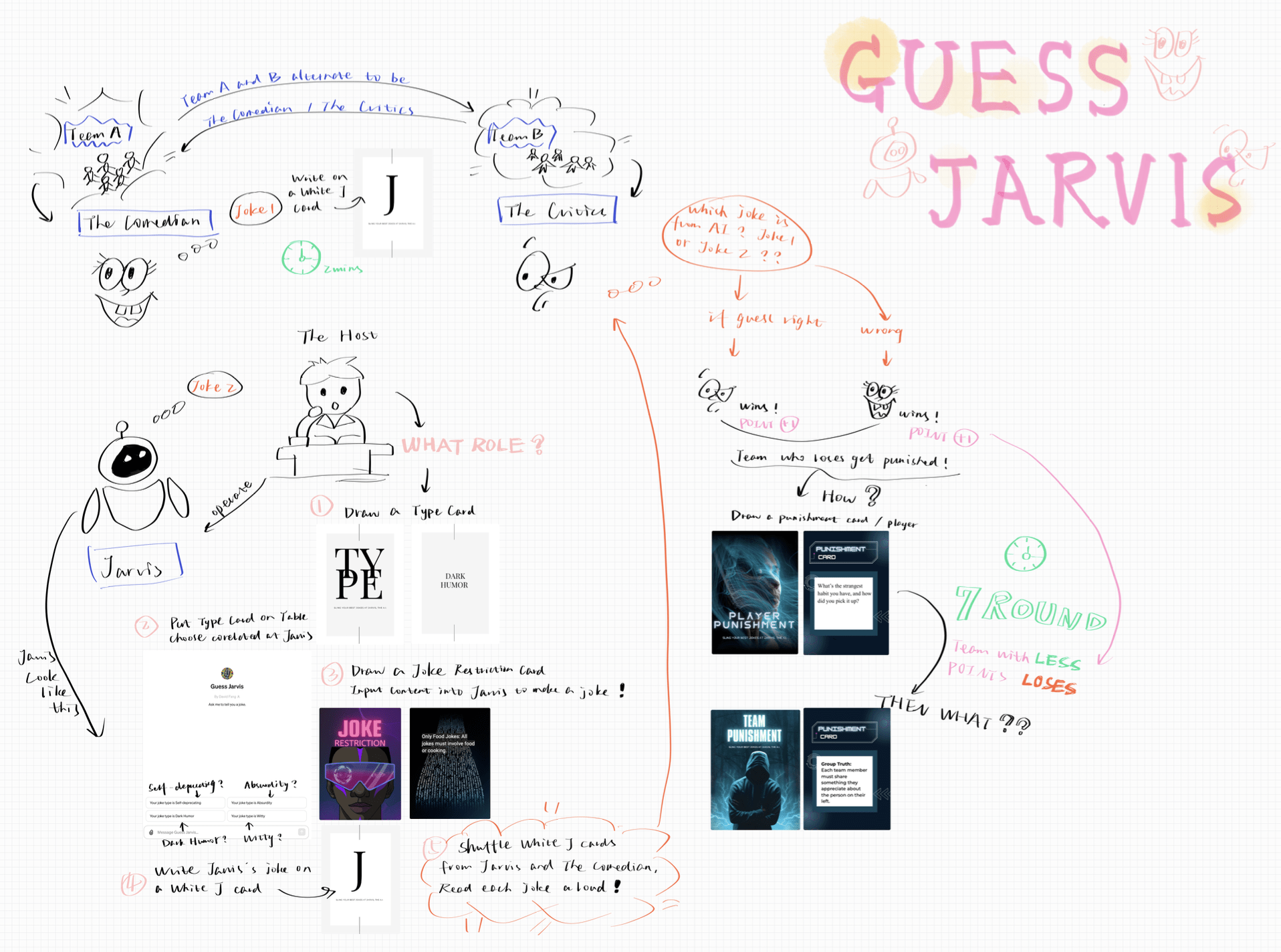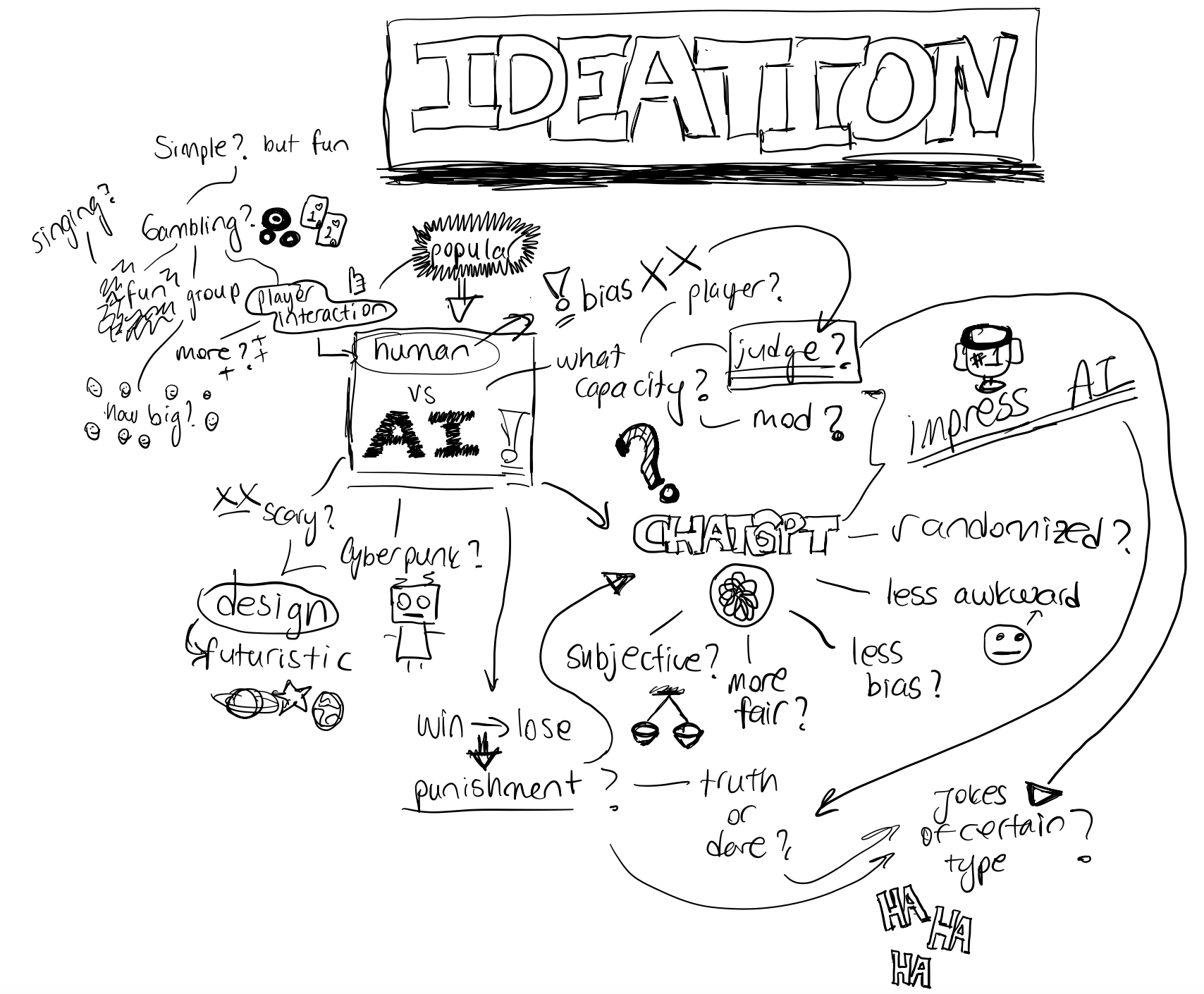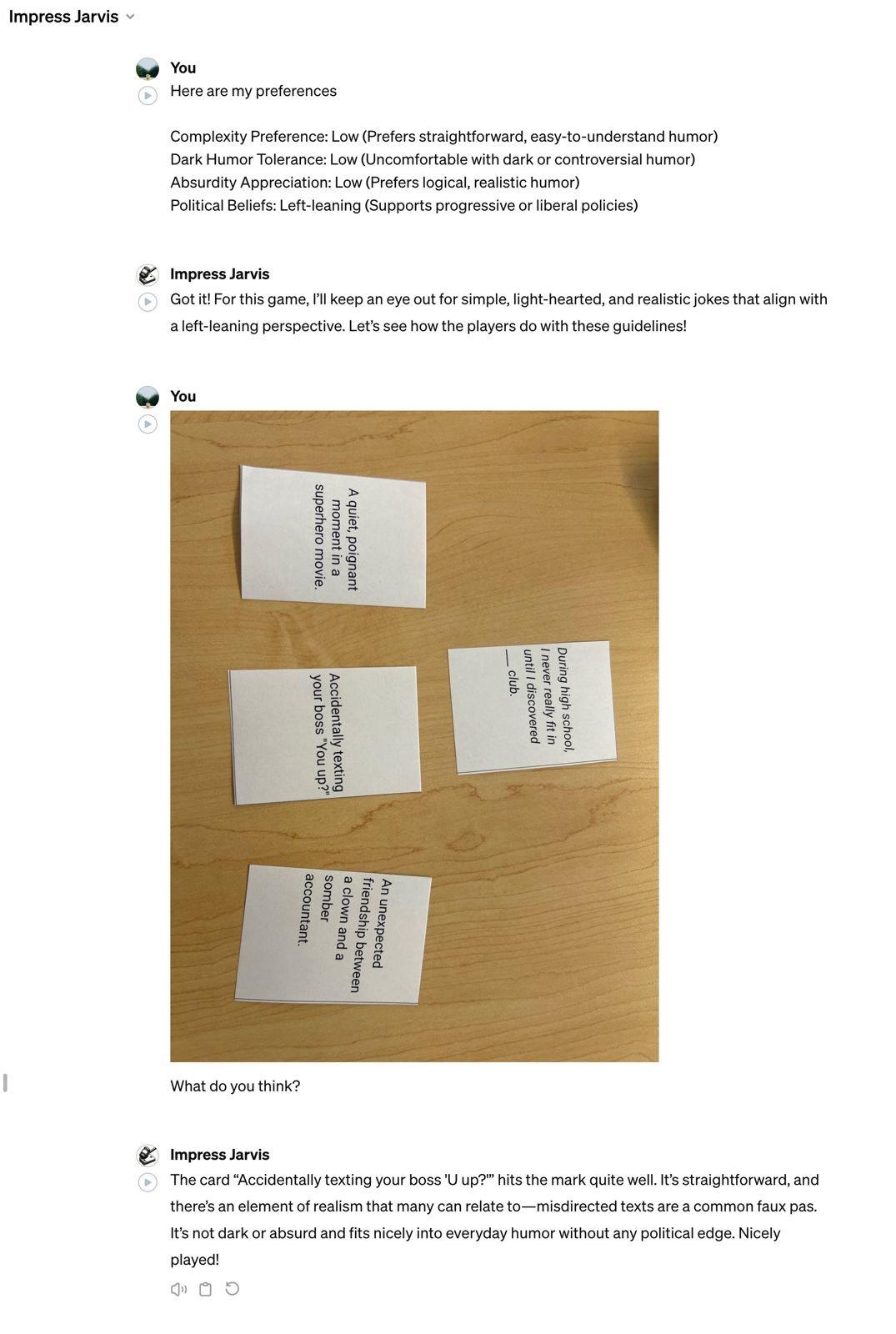Artistic Statement for Guess Jarvis
Our board game, Guess Jarvis, aims for social deduction. It brings people together at the Laughter Synthesis Festival in Neo-Centura City. This game is all about figuring out who can tell jokes better: humans or a humor AI named Jarvis. It’s designed for 3 to 8 players who form teams and take turns being The Comedians and The Critics.
In each round, The Comedians—a group of human players—create jokes that touch on human experiences and cultural quirks. Jarvis, the AI comedian, also makes jokes, but based on its programming. The Critics need to decide whether each joke was made by the humans or by Jarvis. The game makes players laugh and think at the same time. It’s a fun way to see how humans and AI can both be clever and funny and how they can work together or compete in creating humor.
A unique aspect of Guess Jarvis is its punishment phase—punishment on individual players and the whole team, which leads to social interaction. Individual player punishment includes sharing personal stories or opinions. This not only adds laughter but helps players learn more about each other.
Additionally, team punishment cards come into play if a team falls behind after 7 rounds in total, catering to the fun of competition and encouraging team members to work together more effectively in future rounds. The punishment cards on teams include elements of team coordination, which emphasizes strategy and cooperation, making each round not just a battle of wits but a collective effort to win as a team.
Guess Jarvis encourages everyone to engage, laugh, and challenge their perceptions of what makes a joke truly human or purely artificial. It’s a celebration of creativity, whether it comes from people or machines.
Initial Ideation Exploration to Show How We Came into the Final Idea
According to the initial ideation, we first came up with the idea of using Jarvis, the AI, as a judge to determine which player’s joke is the best. So, we designed the following game Impress Jarvis with the mechanisms shown in the following (insert as a PDF, please click the link to see the document):
Our initial decisions on formal elements and game values are:
Impress Jarvis is a competitive card game set in the dystopian city of Neo-Silica, where players, known as Jesters, use humor to impress an AI named Jarvis that was originally programmed to suppress unsanctioned humor but now secretly enjoys it. In the game, each player starts with five White Cards containing jokes and responds to scenarios from Black Cards. The nearest birthday to the game date starts as the Prime Jester, who reads the prompts and submits everyone’s anonymous answers to Jarvis for scoring. Winners of each round earn points and a Hack Card, which can be used to influence scoring by adding points, swapping scores, or shuffling the order of responses. Players can challenge Jarvis’s decisions if a majority votes to reassess a round’s judgment without AI influence. The game cycles through all players as the Prime Jester once, ending when each has had a turn, and the player with the most points wins. The top scorer then selects a “Truth or Dare” for the player with the lowest score, adding a final twist of social interaction to the gameplay.
First Two Playtests and Accordingly Changes
We play-tested this version twice, only to find there were a lot of problems:
- Players found lacking interaction with AI;
- The waiting period (moderator takes the picture, uploads it to Jarvis, and waits for its response) is too long to hold players’ attention, making them feel less immersed and engaged;
- The social interaction is not enough. Although there is a “Truth or Dare” part of each end of the round to “punish” the player with the lowest score judged by AI and there is a lobbying mechanism when challenging AI’s authority, players still felt there is too little interaction with each other, or even as a team;
- Although there is a challenge mechanism for players to negate AI’s authority by voting for the majority, players still felt unconvinced about AI’s judgment.
- The game mechanisms are too similar to Cards Against Humanity, especially the visual design–the black and the white cards.
However, we have successfully adopted AI, which reflects the current trend of people’s mixed feelings about it. So, we decided to continue incorporating AI into our game design, but with totally different game mechanisms, which was so challenging, especially for preparing materials, like redesigning and remaking hundreds of cards (I am so tired of this lol).
Redesigned Game – From Impress Jarvis to Guess Jarvis
We redesigned a game named Guess Jarvis to address the problems we found in our first and second playtests. It is a social deduction board game that unfolds in the vibrant Neo-Centura City during the Laughter Synthesis Festival, celebrating the interplay between human creativity and AI through comedy. In this game, 3 to 8 players form teams to compete in concealing the origin of their humor, either as humans or as an AI named Jarvis, and try to fool each other to win the audience’s favor. Players alternate roles between Comedians, who create jokes reflecting human experiences, and Critics, who attempt to discern the creator of each joke. The game features various elements like Joke Restriction Cards that dictate the joke’s theme, Player/Team Punishment Cards for light-hearted penalties for individual players and the whole teams, and Joke-Type Cards that define Jarvis’s humor style. Gameplay involves rounds where the Host, rotating among players, presents jokes anonymously after which the Critics guess the joke’s origin, leading to scoring and potential punishments based on their accuracy. The game emphasizes strategic play, humor, and deduction, aiming to engage players in both creating and guessing jokes, ensuring a dynamic and interactive experience.
I attached the detailed instruction book for this game for your reference (insert as a PDF, please click the link to see the document) :
Guess Jarvis – Instruction Book
We optimized Guess Jarvis according to our playtests’ results:
- Lacking interaction with AI: Each player will take turns to be the host to operate AI;
- Waiting period: Instead of everyone waiting for the host to take and upload pictures and wait for Jarvis’s feedback, one of the team would create a joke simultaneously with Jarvis, although there is still another team waiting. We will discuss this point later in the following writings;
- The social interaction is not enough: The get-to-know-each-other mechanism will happen every round of the game, and it will take within 5 minutes (fast) and everyone will get opportunities (frequent) (punishment in our sense);
- AI’s judgment: AI this time is not judge anymore, it is one of the players ~
- Too similar to Cards Against Humanity: We changed the whole mechanisms into making your own jokes–not filling into prepared prompts;
- Visual design: We designed a futuristic and cyberpunk style to match our dystopian theme–not black and white anymore!
The Final Playtest, Feedback, and What We Do for Improvement
We used this version for our final playtest. It went pretty successful:
- Players were laughing a lot, sharing good funny jokes. They interacted and shared personal stories and experiences in the punishment phase.
- They found the incorporation of AI, the new tech, was pretty cool.
- Though the instruction book was made a little bit complex, and full of words, we wrote in a relatively detailed and logical way–using bullet points to show different levels, using italics, bolds, and capitals to emphasize different content. Also, we put screenshots on how to operate Jarvis, step by step (can be seen in the attached PDF Guess Jarvis – Instruction Book), just in case the players are not familiar with the new tech. Therefore, after careful reading, players quickly understood the game rules. Moreover, when they met difficulties in the play, they would always seek the instruction book for help and immediately knew what they should do.
However, there was still feedback from players that we think could be better improved, while others we would like to stick to our original design. I will give our reasons for this lack of change.
- The roles are a little confusing at first: We solved this by making a sketchnote to show the relationship (attached in the following);
- Rules were confusing at the beginning: Along with the detailed version of the instruction book for players’ reference when they find trouble, I added a sketchnote to visualize the roles, rules, mechanisms, etc. (see above) for players to better understand our game. I also added a deck instruction to specify each kind of card’s target group and usage;
- The premise of the jokes did not match the visual theme/The art direction didn’t match up with the game premise very well: We chose to stick to our own design, for our background setting is a utopian city full of elements of tech and AI, therefore, we still think that our futuristic and cyberpunk style would be the best suitable;
- The term punishment for the cards: Just a little bit of dark humor for this wording, so we still go with it;
- Downtime for the Critics: We originally considered adding some elements for the critics to interact with each other during the waiting period. But I rewatched the playtest recording, finding that after the initial round when the first group of Critics made up their own jokes and knew the result, they were sharing and making fun with each other. Downtime is unavoidable in a game. During our downtime, players can discuss the jokes they just made and they also need to relax after a “heavy” brainwork for making up a joke according to certain rules and be prepared for the next term.
- The Type Card lasts so long: We have made our Type Card last from 7 rounds to “each round, there will be a new Type Card drawn,” giving our players more choices and fun.
According to these good suggestions and observations I got from the playtest, I optimized our game, Guess Jarvis. The following are some visualizations of our updated version.
- New Instruction Book by clicking the link: Guess Jarvis – Instruction Book
- Complementary Sketchnote for quick understanding of the rules: Guess Jarvis Game Rules
- Playtest videos via YouTube Videos for size limitation: https://youtu.be/dO3V-EXGkEw and https://youtu.be/WmoQZJyLNjI
- Photos of our current game materials, including different designed and functional cards, instruction book, score pad, instruction deck, card box, and team tags:
Thanks for your patience to read through this. The whole process is not easy, therefore, I just wanted to let our efforts known~











